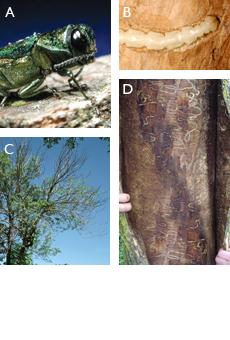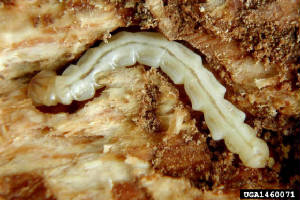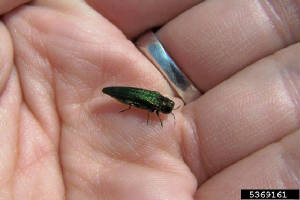|
|
Emerald Ash Borer (EAB)
The Emerald Ash Borer (EAB) is an invasive pest introduced from Asia that attacks ash trees (Fraxinus spp.) This metallic wood boring beetle was found in Detroit, Michigan and Ontario, Canada in 2002, and has continued to spread into neighboring states and eventually across the U.S. and Canada. The adult is a small, metallic green beetle only 10-15 mm in length and about 3 mm in width. The larvae live under the bark of the tree and feed in the vascular cambium. The adults typically emerge around June, leaving D-shaped exit holes in the bark. This ash tree insect briefly feeds in the canopy before reproducing and laying eggs in the twigs and branches.
Symptoms
EAB larvae live under the bark and feed on the vascular tissues. Larvae create meandering galleries through the phloem, vascular cambium and etch the xylem, effectively girdling the tree. The tree responds by sprouting new (epicormic) branches below the disrupted tissues. Dieback of the canopy is a symptom of EAB larval infestation as many as one half of the branches may die back as infestation progresses. The bark will split over dead vascular tissues, and trees may die within only two years of the onset of symptoms. . When To Treat Treat ash if EAB is reported in your area. Do not wait for visible dieback in the canopy, as there is a significant delay between disruption to the vascular tissues and expression of symptoms in the canopy. Delaying Emerald Ash Borer treatment could result in canopy dieback or tree loss. Applications should be made in the spring, about 30 days prior to expected adult emergence; however, treatment may be applied during the growing season (May through July) to protect trees. Uptake of formulation is fastest when trees are actively transpiring, after they have developed a full canopy. Emerald Ash Borer treatment in the spring will prevent the adult beetles from feeding and laying eggs in the tree, whereas summer treatment will kill the larval stage of EAB feeding under the bark. Make summer treatment applications in the morning when temperatures are moderate. If soil is dry, water trees prior to treatment. Injection in the fall (after leaves color) can protect the tree for the following season. Trees need to be closely monitored for symptoms of EAB as infestation builds in your area. In general, applications are not made more than once a year. Specific insecticide formulations for EAB may provide 2 years of activity. More Photos of EAB
|




